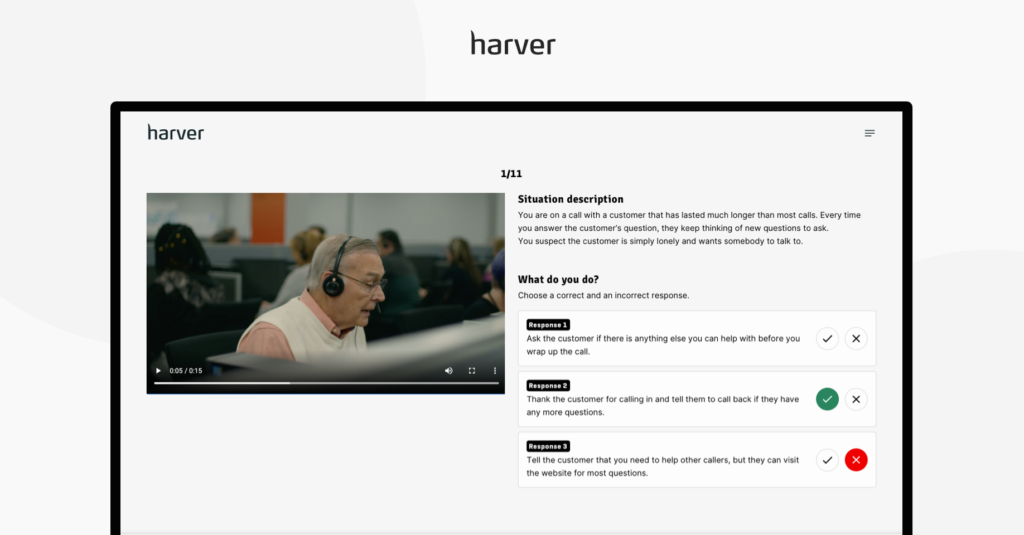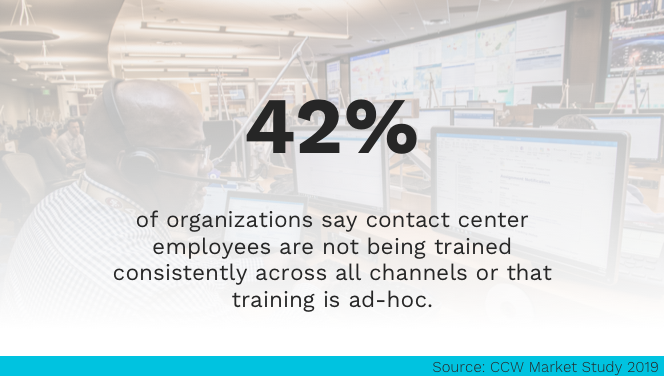If you work in the call center industry, you don’t need us to tell you that contact centers are transforming. They’re no longer only places that take calls and answer questions but fast forward to today, and they’re also hubs for omnichannel communication.
Despite the importance of contact centers in customer communication and the evolving technologies that support them, they still face the same hiring challenges as they have for years. High employee turnover is their number one problem.
But beside this, what are the main difficulties contact centers tackle when recruiting new employees? And how can they solve them?
What’s in?
Like what you see?
Don’t miss out. Subscribe to our quarterly digest to get the latest TA and TM resources delivered right to your inbox.
1. High employee turnover
High attrition rates present a considerable problem for any company. When staff leave and new employees have to be hired, this requires you to shell out time and money for recruiting, training, onboarding, and mentoring.
In other words, precious resources are wasted again and again until the new hire is up to speed, and they’re finally as productive as the employee they replaced. In the meantime, the quality of your customer service might also suffer as a result.
High contact center attrition rates can be caused by many things, including management styles and low job satisfaction. But long before these causes can take effect, it’s clear that an employee that’s not a fit the company won’t have a future there.
So, how do you stop hiring the wrong people?
For starters, you can build and advertise a realistic image of your organization. It’s crucial you make this known during the pre-hiring stage to attract the right candidates.
Here are a few tips for doing precisely that:
- Provide a thorough explanation of the role in your job ads.
- Set realistic expectations throughout the hiring process
- Assess the skills necessary for successful contact center agents and evaluate these parameters in each potential recruit.
Let’s dive into the details.
- White paper
Before you continue!
Don’t forget to grab your free copy of our white paper on contact center volume hiring in 2021. Learn about:
- The challenges currently shaping the contact e
center recruitment space - How employers can navigate the new remote-first reality, and the role of technology in a future-proof recruitment process
- The four building blocks of a fully digital recruitment process

2. Setting the right expectations
As we’ve just alluded to, setting realistic expectations is of paramount importance. Going into a new job with a false image of the job role, company culture, benefits, etc., never bodes well.
So, setting the right tone in your job ad and throughout the entire recruitment process, helps nip disappointment in the bud before it manifests itself, and people quit early.
In light of that, prepare employees for the less glamorous aspects of the job. Including the fact they’ll have to deal with:
- Lots of frustrated customers
- Answer questions they don’t know the answers to immediately
- Spend long hours on the phone
Our best advice is to incorporate both a realistic job preview and a situational judgment test as part of your selection process. This helps to communicate the realities of the job from the get-go.

3. Assessing for essential skills
Too often, contact centers aren’t even aware of the skills they should be looking for in potential employees, let alone how to assess them. Needless to say, identifying and testing for critical skills is essential for hiring top-quality talent.
So, how do you uncover these important abilities? The answer is easy, observe the habits and qualities of your top-performing customer service agents, and look at industry data. This should provide all the data you need to identify the skills you should be assessing candidates for.
To evaluate an applicant’s skill set, you can use a situational judgment test (as previously mentioned). Then, continue to examine these attributes by asking pointed interview questions. You could even ramp things up a notch by setting the candidate a ‘real-life’ assignment that assimilates an everyday problem a call center employee might face. Then observe how the potential recruit performs in action.
This is an excellent way of getting a feel for the quality of the candidate’s transferable skills and experiences, that simple background data just can’t communicate.
To help you get going, here are a few examples of the talents employees need to possess to shine in this industry:
- Customer orientation
- Stress management
- Tech-savviness
- Communication skills
- Effective problem-solving
Of course, the skills you need to excel at a contact center don’t just revolve around communication. Depending on the industry, employees might also require in-depth knowledge of the subject matter, be this travel or IT. So, be sure to test for this too but bear in mind that the knowledge can be learned. That’s why you might want to prioritize other characteristics and skills in your hiring process.
Experience our best-in-class Live Chat Assessment first-hand!
Perfect for remote hiring, our live chat assessment makes it easier than ever to hire live chat agents. Candidates experience the job, while you get actionable data to drive hiring decisions.
4. A lack of data
If you’re facing high attrition rates, it can be hard to spot what went wrong immediately.
This is where exit interviews come into their own. They’re incredibly useful for deciphering why employees left your company. But, without a set of metrics to measure and record this info, this knowledge won’t provide a concrete foundation for improved strategy.
This is why using HR or talent analytics to collect data on the workforce, their efficiency, pain points, and the habits of high performing employees and managers are essential.
This data provides you with the basis you need to enhance your current processes and propose vital solutions to commonly faced issues.
For instance, HR analytics might tell recruiters where they’re going wrong during interviews, or why their turnover rates are so high. Data is essential for understanding and fuelling your recruitment and employment processes, improving employee satisfaction, and lowering attrition.
5. Unstructured recruitment process
An unstructured recruitment process often leaves candidates confused and HR staff unsure of what to look for. With the above point – the lack of data – in mind, several things often go wrong as contact centers screen for new employees. Most notably, recruiters don’t have a consistent, structured approach, which doesn’t lead to a consistent quality of hires.
The solution, of course, is to ensure each application, interview, and screening process follows an optimized structure that’s based on accurate data.
Sketching our your recruitment funnel and visualising your candidate journey will help you understand the candidate touchpoints with your organization and see the weaker parts of your process. Find out where the bottlenecks of your hiring process are and research how you can improve your process.
If you’d like to see how Harver can help you streamline your recruitment process and turn it into a fully digital one, you can book a demo below.
If you’d like to see how Haver can transform your hiring process,
book a demo here!
6. Building an attractive EVP
An EVP (employee value proposition) refers to the rewards and benefits employees receive in exchange for their performance. Contact centers have got a pretty bad rap for treating employees as expendable workers with notoriously low wages. They, therefore, have trouble positioning themselves as desirable places to work.
This is just one reason why it’s essential to work on building an attractive employee value proposition and showcasing it. Look into what you can offer employees and what your company culture’s like. Then be consistent in your EVP.
This is also an excellent chance to improve your company culture and benefits system (especially if you’re finding it hard to present both of these positively). It goes without saying, a good EVP will attract employees that are keen to perform well, passionate about their job, and strive to do their best work.
A weak EVP, on the other hand, may only attract recruits that can’t afford to be picky about their job. As such, they’ll likely see your contact center as temporary work while they wait for a better opportunity.

Concentrix, a specialist in customer engagement, focuses on professional and career development and learning in their EVP, which they also clearly present on their career page.
7. Seasonal hiring
It’s common for contact centers to experience a surge in workload over certain times of the year. For example, for retailers, December is especially stressful, with Christmas shoppers looking for gifts. For travel companies, it’s the summer months.
To prepare for these times, call centers might need extra help, which prompts seasonal hiring. To succeed in this type of volume hiring, start with a well-designed recruitment plan, which tells you exactly who you need to hire and when.
Kickstart this recruitment campaign well in advance of the busy season to avoid unnecessary rushing. Consequently, you won’t have to demand too much more of your current workforce and can, therefore, remove unnecessary stressors leading to a dip in morale.
8. Hiring remote employees
There are several reasons why remote working is increasingly popular both for employees and companies:
- It expands the potential talent pool considerably
- It offers employees the benefit of working flexibly and from home
- It’s easier to find more agile staff to cover unexpected business changes.
In light of that, contact centers need to ensure their remote workers are capable of doing the job and have sufficient hardware and software to do the job justice.
Recruiters can use online assessments and video interviews to evaluate the candidate and use system diagnostic assessments to see if their equipment is sufficient.
9. Inadequate onboarding
If contact centers fail to hire new employees ahead of time, they often rush to set new recruits straight to work and require them to be productive from the start.
All too often, this results in the onboarding phase being neglected entirely.
However, this is the stage where employees should learn the ropes, best practices, and settle into the workplace. When call centers don’t set time aside for onboarding, new employees typically find themselves under lots of pressure straight away, which can lead to burning out and quitting. Unsurprisingly, burned-out recruits are more likely to make mistakes before they’ve even had a chance to become comfortable in their new job.
So, plan and execute a pre-boarding phase that gets new hires excited about working for you. You can help them settle in faster by preparing a thorough training plan, assigning them a mentor or buddy, and regularly checking in with them.
Most importantly, as we’ve already discussed, call centers should avoid hiring when they already need extra help. Instead, they should focus on anticipating their busier times and hire well in advance.
10. Limited training budgets
In line with the onboarding process, many contact centers don’t allocate enough time or budget to train new employees.
Mentoring schemes remain, to this day, one of the most common training techniques. Whereby new employees sit next to seasoned employees and listen in on their calls and watch how they navigate CRM software.
While one-on-one training can be beneficial to a degree and helps new employees settle in, it’s not always sufficient. Seasoned workers may develop bad habits and pass these onto new recruits.
This is why investing in high-quality training and development for employees not only provides extra value to staff but keeps everyone on the same page. By setting a clear standard of what’s expected from new hires, they’re more likely to reach or even exceed your expectations.

Inconsistency in training and development is often an issue in contact centers. Having a solid training plan in place will not only help you retain your employees but also enable them to provide the best service to your customers.
11. Retention
The recruitment process shouldn’t end after hiring and onboarding a suitable employee.
Instead, to retain staff for the long haul, you need to start measuring the success of your recruitment processes by evaluating the performance of new employees for a minimum of three months. In this time, efforts should be taken to maintain momentum, motivation, and encourage employees to invest in their jobs long term. The first three months are often the most dangerous for attrition, as this is when new candidates might waver and leave.
Also, it’s worth bearing in mind that retention is directly influenced by the quality of management, employee benefits, and office culture. So, use analytics to measure these potential pain points within your workforce, and then improve your internal processes to ensure you provide employees with adequate support.
Next steps
These are just a few of the things you can do to ensure new employees have a great start with your company. Inevitably, this will result in them staying longer, and of course, retaining trained and efficient staff leads to a higher bottom line for your contact center.
If you’d like to see how Harver can support you in tackling these challenges and hiring faster and better, you can book a demo below.
Ready to transform your hiring process?



